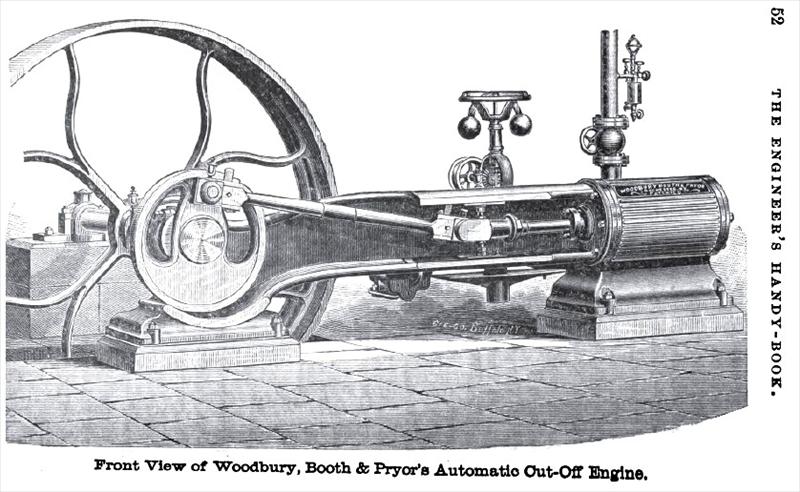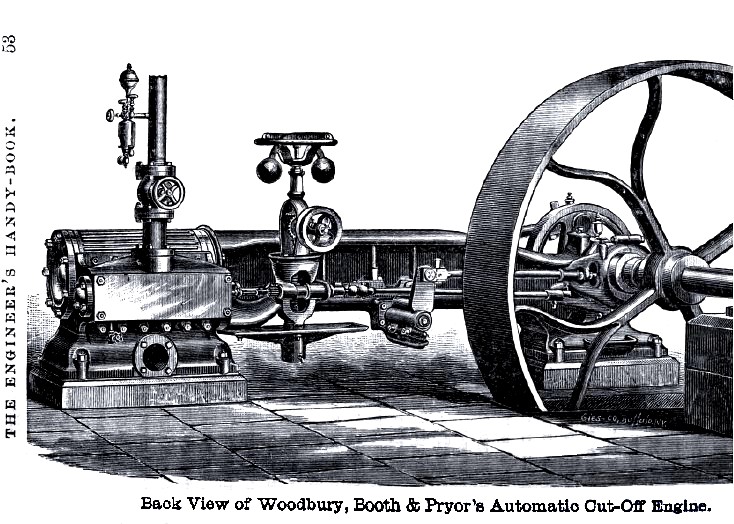|
Title: |
1884 Images-Woodbury, Booth & Co., Steam Engine |
|
Source: |
The Engineer's Handy Book 1884 pg 52 & 53 |
|
Insert Date: |
2/10/2016 1:27:18 PM |
Woodbury, Booth & Pryor's Automatic Cut-Off Engine.
The cuts on pages 52 and 53 represent Woodbury, Booth & Pryor's Automatic Cut-off Engine. It will be observed that it is built upon what is known as the girder or truss frame, a design which has been received with more favor, and more universally adopted by intelligent engineers, both in this country and Europe, than any other. In fact, it is fast superseding all previous forms of bed-plates. This perhaps arises from the fact that it is the best disposition that can be made of a certain quantity of material, to insure strength and rigidity without extra weight, as the centre line of the frame coincides with the plane of the line of the strains and with the centre line of the engine. It is faced at one end to receive the false head between the frame and cylinder, the piston-rod stuffing-box being cast with the head. The cylinder rests on a handsomely designed pedestal, the other end of the frame containing the back leg and main pillow-block bearing.
Valve-Gear—The main valve is an ordinary D slide-valve, an arrangement which, since the advent of the steam-engine, in consequence of its simplicity of design, positiveness of action, moderate first cost, non-liability to become deranged and get out of order; that it performs the double function of admission and release, as well as from the ease and convenience with which it can be repaired or removed, has held its own against all new innovations in steam-valves and valve-gear. Fig. 1 shows a horizontal section through its centre, and, as will be observed, it is driven by an eccentric on the main shaft through the intervention of a rocker-arm. The cut-off valve, a section of which may be seen in Fig. 2, is cylindrical in form, and works in a small cylinder attached to the back of the main valve, which is cast in one piece with it. In consequence of the arrangement of the ports, it is perfectly balanced; and, owing to its having diagonal admission edges, with ports to correspond, by rolling it slightly in its seat it will cut off at any point between zero and three-quarter stroke, according to requirements.
The cut-off eccentric rod connects with the slide working in the bracket by means of a ball-and-socket joint, which allows the valve to rotate in its seat, more or less, according to the requirements of the load and pressure. The rotation, which never exceeds one-quarter of a revolution of the valve, is accomplished by a segment on the cut-off valve-slide, working into a rack attached to the governor spindle. The slide is a round steel rod, having a number of grooves milled in it lengthwise, sliding through corresponding tongues in the segment. This arrangement places the cut-off at all times under complete control of the governor, and, of the valve in its seat, it offers but very slight resistance, and induces less friction, even, than that of an ordinary throttling-valve. These cut-offs embody the following advantages: Simplicity of construction, positiveness of action, an entire absence of releasing gear, non-liability of derangement, freedom from violent shocks, accuracy in cutting off, and uniformity of speed.
The Governor.—The governor is of peculiar design; the arms extend across the centre, and have their point of suspension on the opposite side of the ball, which insures great sensitiveness, as they have a very extensive range of movement with a slight variation of speed. Besides, the governor has comparatively no work to perform, as the rolling of the balance cut-off while sliding lengthwise in its seat requires but a very small amount of force. In fact, the governor has nothing to do but to regulate the speed, without being hampered by the movement of cut-off valves, that have large rubbing surfaces exposed to boiler pressure.
The arrangement for the admission and release of the steam to and from the cylinder automatically, embodies the right principle by which to work steam expansively and economically. There are numerous industries in which uniform speed is not only a desideratum, but a necessity. • It must not be understood, however, that all automatic cut-offs and governors are capable of producing satisfactory and economical results, as many of them in use at the present day fail to meet these requirements. The governors of these engines are provided with a dash-pot, which acts as a cushion, and obviates the jerking so common in many governors, and which -is so detrimental to the uniform working of an engine.
Some of the advantages of the Woodbury, Booth & Pryor engines are, that they are handsome in design, and convenient and simple in arrangement; that they are built of the best materials, fitted with the greatest care, and steel and composition metals are freely used on parts subjected to the most wear, thus insuring durability as well as reducing the cost of maintenance to a minimum; that there is secured the highest degree of economy and the closest approximation to uniform speed; that the ports are dropped sufficiently low to drain the cylinder, the water of condensation being drawn from the steam-chest instead of being forced through the cylinder; that owing to the positive valve-motion they can be run at a high rotative speed; that provision is made for catching all the drip oil and water; that the crank-pins have a hollow cellar or receptacle in the centre for the purpose of containing an auxiliary lubricant, which will melt and prevent the pin from cutting should the oil-cup be neglected or fail to feed; and that all wearing parts can be easily and accurately adjusted.
In fact, these engines seem to embody all the good points in the best descriptions of engines, and many others which are peculiar to themselves, which render them equal, if not superior, to any other automatic cut-off engines in the market. They are manufactured by Woodbury, Booth & Pryor, Rochester, N. Y. |
|
 1884 Woodbury, Booth & Co., Steam Engine
1884 Woodbury, Booth & Co., Steam Engine
 1884 Woodbury, Booth & Co., Steam Engine
1884 Woodbury, Booth & Co., Steam Engine
|
|